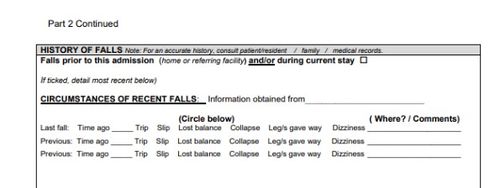Unknown Facts About Dementia Fall Risk
Excitement About Dementia Fall Risk
Table of ContentsA Biased View of Dementia Fall RiskDementia Fall Risk Can Be Fun For AnyoneDementia Fall Risk Fundamentals ExplainedThe Facts About Dementia Fall Risk Revealed
A fall danger evaluation checks to see just how likely it is that you will drop. It is primarily done for older adults. The analysis normally includes: This consists of a collection of inquiries about your total health and wellness and if you have actually had previous drops or issues with balance, standing, and/or walking. These tools check your strength, balance, and gait (the method you walk).STEADI includes testing, examining, and treatment. Interventions are recommendations that might lower your threat of falling. STEADI consists of 3 actions: you for your danger of falling for your danger variables that can be boosted to attempt to prevent falls (as an example, equilibrium troubles, impaired vision) to lower your danger of dropping by utilizing efficient strategies (as an example, providing education and sources), you may be asked numerous inquiries consisting of: Have you fallen in the past year? Do you feel unstable when standing or strolling? Are you fretted about falling?, your service provider will certainly examine your stamina, equilibrium, and stride, making use of the following autumn evaluation devices: This examination checks your stride.
After that you'll take a seat once again. Your supplier will examine the length of time it takes you to do this. If it takes you 12 secs or even more, it might mean you are at higher risk for a loss. This examination checks toughness and equilibrium. You'll rest in a chair with your arms crossed over your breast.
The placements will get more difficult as you go. Stand with your feet side-by-side. Relocate one foot midway forward, so the instep is touching the big toe of your other foot. Relocate one foot fully before the various other, so the toes are touching the heel of your other foot.
Some Known Details About Dementia Fall Risk
Many drops occur as a result of several contributing elements; consequently, managing the danger of dropping begins with determining the factors that add to drop danger - Dementia Fall Risk. Several of one of the most relevant risk elements consist of: History of prior fallsChronic medical conditionsAcute illnessImpaired gait and equilibrium, reduced extremity weaknessCognitive impairmentChanges in visionCertain risky medicines and polypharmacyEnvironmental elements can additionally boost the danger for falls, consisting of: Poor lightingUneven or damaged flooringWet or slippery floorsMissing or damaged hand rails and order barsDamaged or improperly fitted equipment, such as beds, mobility devices, or walkersImproper use assistive devicesInadequate supervision of individuals staying in the NF, consisting of those who show hostile behaviorsA successful loss risk management program needs a thorough professional evaluation, with input from all participants of the interdisciplinary team
.png)
The treatment plan ought to likewise include treatments that are system-based, such Full Report as those that promote a risk-free environment (ideal lights, handrails, get bars, and so on). The efficiency of the interventions ought to be assessed periodically, and the treatment plan revised as needed to reflect changes in the loss risk assessment. Applying a fall threat management system making use of evidence-based finest technique can minimize the prevalence of drops in the NF, while restricting the capacity for fall-related injuries.
Dementia Fall Risk Can Be Fun For Anyone
The recommended you read AGS/BGS standard advises screening all adults aged 65 years and older for loss risk yearly. This testing includes asking patients whether they have actually dropped 2 or more times in the previous year or looked for clinical attention for a fall, or, if they have not fallen, whether they really feel unstable when strolling.
Individuals who have actually dropped as soon as without injury should have their balance and stride evaluated; those with gait or balance problems should obtain extra evaluation. A background of 1 autumn without injury and without gait or equilibrium issues does not call for additional evaluation past ongoing yearly fall threat testing. Dementia Fall Risk. An autumn threat analysis is called for as component of the Welcome to Medicare exam

The 3-Minute Rule for Dementia Fall Risk
Recording a falls history is one of the top quality signs for fall prevention and management. Psychoactive medicines in specific additional info are independent forecasters of falls.
Postural hypotension can typically be relieved by reducing the dose of blood pressurelowering drugs and/or quiting medications that have orthostatic hypotension as an adverse effects. Usage of above-the-knee assistance hose and resting with the head of the bed boosted might additionally reduce postural decreases in blood pressure. The preferred aspects of a fall-focused physical exam are received Box 1.
-copy-5.jpg)
A pull time higher than or equal to 12 secs recommends high fall threat. The 30-Second Chair Stand test assesses lower extremity strength and equilibrium. Being not able to stand from a chair of knee elevation without utilizing one's arms indicates boosted loss threat. The 4-Stage Equilibrium test assesses fixed balance by having the individual stand in 4 settings, each progressively much more difficult.